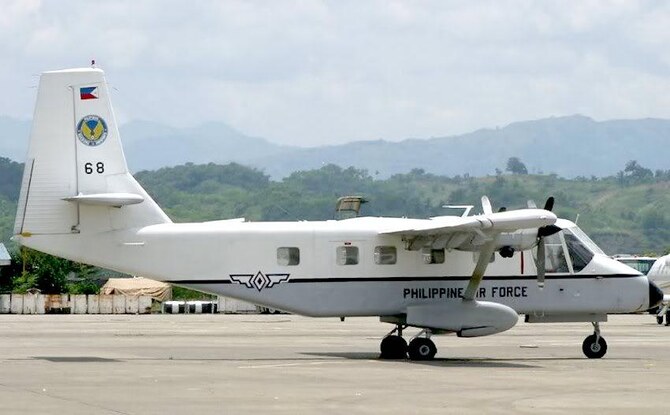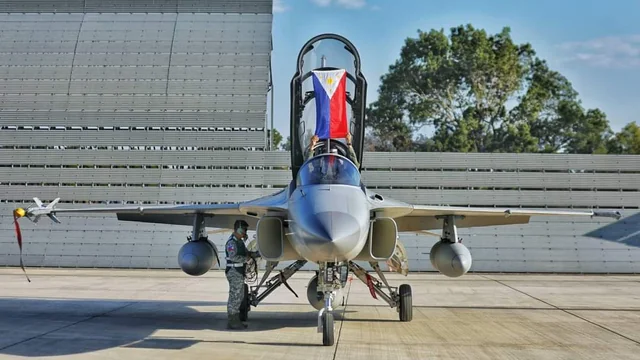Philippines Considers Deploying FA-50 to Escort Its Maritime Patrol Flights in South China Sea
Following a dangerous maneuver by two Chinese fighter jets against a Philippine patrol aircraft over the South China Sea last week, Manila is considering deploying its South Korean-made FA-50 Light Combat Aircraft (LCA) to escort its patrol aircraft during operations over the resource-rich waters.
(DEFENCE SECURITY ASIA) — Following a dangerous maneuver by two Chinese fighter jets against a Philippine patrol aircraft over the South China Sea last week, Manila is considering deploying its South Korean-made FA-50 Light Combat Aircraft (LCA) to escort its patrol aircraft during operations over the resource-rich waters.
Philippine Defense Secretary Gilberto Teodoro Jr. stated that it is essential to discuss the possibility of deploying the Philippine Air Force’s FA-50 fighters to escort its patrol aircraft during missions over the South China Sea.
“It will be a prolonged struggle to assert our presence and emphasize our sovereign rights in the area, so you should expect these kinds of incidents to continue,” he said.
In last week’s incident near the disputed Scarborough Shoal, two Chinese fighter jets performed dangerous maneuvers, including releasing flares in the flight path of a Philippine NC-212i patrol aircraft conducting a routine mission over the South China Sea.
All crew members and passengers on the Philippine patrol plane were unharmed, and the aircraft safely landed at Clark Air Base in northern Manila.
High-level defense sources in the Philippines reported that the Chinese fighter jets flew dangerously close to the propeller-driven Philippine patrol aircraft, endangering the lives of its crew and passengers.

The Chinese jets reportedly released eight flares during the aggressive maneuver.
Meanwhile, Acting Colonel Rifiel Santiago Sotto from the Public Affairs Office of the Philippine Air Force was also asked about the Chinese fighter jets’ aggressive actions.
He noted that the FA-50 fighter jets are the only assets capable of challenging the air power of the Chinese Air Force.
“At this point, nearly everyone is aware that we (the Philippine Air Force) have FA-50s in our inventory,” he said.
While the deployment of the Philippine Air Force’s FA-50 fighters to escort patrol aircraft over the South China Sea is still in the preliminary stages, the presence of FA-50s in the area is almost certain if the situation deteriorates.
The Philippine Air Force currently operates 12 FA-50PH light fighters, developed by South Korea’s Korea Aerospace Industries (KAI).
All 12 aircraft are in service with the Philippine Air Force’s 5th Fighter Wing.

In addition to the Philippines, Thailand and Indonesia are Southeast Asian countries that operate variants of the FA-50/T-50 fighter/trainer jets.
Thailand operates 14 T-50s, the Philippines 12 FA-50s, while Indonesia has 22 T-50s in its fleet.
Last May, Malaysia signed a contract worth approximately RM4 billion to acquire 18 of the latest variant of the FA-50 Block 20 light fighters, known as the FA-50M.
The Royal Malaysian Air Force (RMAF) is expected to start receiving these aircraft by late 2026.
The FA-50PH light fighter is currently the most capable fighter aircraft in the Philippine Air Force, but the Southeast Asian nation is expected to make a decision on its choice of a Multi-Role Combat Aircraft (MRCA) soon.
Two fighter jets are fiercely competing for the contract: the F-16 developed by Lockheed Martin from the United States and the JAS39 Gripen developed by Saab Group from Sweden.

According to regional defense observers, the Swedish-made JAS39 Gripen is considered the frontrunner in the competition.
In addition to MRCA aircraft, the Philippine Air Force has also expressed interest in expanding its fleet of FA-50s developed by Korea Aerospace Industries (KAI), particularly more advanced variants of the aircraft.
“Yes, it is an option (to add more FA-50s). The FA-50 is an excellent lead-in trainer aircraft, and it can be considered a multi-role fighter as it can perform both air-to-air and air-to-ground operations.”
“The aircraft provides pilots with excellent training opportunities before transitioning to more advanced jets,” said Philippine Air Force Commander Lt. Gen. Connor Anthony Canlas Sr., as quoted by the Philippine News Agency in 2022. — DSA



Comments are closed.